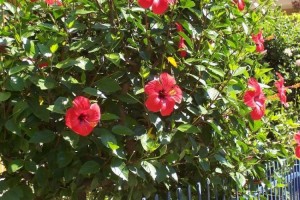Sick Chinese hibiscus (Hibiscus rosa-sinensis)
 Question from Connie:
Question from Connie:
I have yellow flower hibiscus on the sides of my garage door.(Southern CA) One has nice green leaves and the other has yellowing leaves. The soil is the same.
Any suggestions?
Answer from Pat:
Chinese hibiscus (Hibiscus rosa-sinensis) needs full sun. Sometimes folks don’t realize one plant is in full shade, another in sun. Variations in weather can at times cause yellow and dropping leaves. One spot in a bed may get colder and hotter than another. Occasionally a water system maybe perfect for one plant and not for another. Sometimes gardens have a bad spot such as eucalyptus or other invasive tree roots getting into one end of a bed and sapping all the nutrition from one plant in a row of otherwise healthy plants. Other times, painters have washed their paintbrushes there or workmen have washed out concrete buckets when the owner’s back was turned. These are all possibilities. Also one must realize the soil may look the same to you but there could be a mysterious difference such as proximity to concrete in one spot and not in another. This usually doesn’t effect the health of hibiscus but it is enough to prevent a hydrangea from ever going blue.
However after one considers all these possibilities, one needs to realize that yellow leaves are usually caused by lack of nitrogen. It is quite likely that though you may have fertilized the other hibiscus well all summer, this one failed to get an adequate supply. If the yellowness is pervasive, this is usually the main cause. If the veins of the plant are dark green but the rest of the leaf is yellow then the problem is that the plant has a lack of iron and/or trace minerals. Sometimes there may be a lack of good drainage. Sometimes people forget to fertilize altogether. Hibiscus are big feeders. Feed them every year throughout the growing season with a balanced organic fertilizer containing iron and trace minerals.
My eldest daughter, Fran, had a Brugmansia plant with yellow leaves outside her front door. All the other plants in the bed looked great but this one looked bad and leaves were getting yellow and falling off. She thought the drainage was fine and irrigation was the same all over the bed. I suggested she go get some chelated iron and trace minerals and treat the ground with that according to package directions, as one would for citrus. Or you could apply a product containing seaweed which also contains iron and trace elements. Then also get some John and Bob’s Soil Optimizer (it contains humic acid and humic acid releases nutrients already in the soil) and apply that according to package directions and also fertilize with Gro-Power fertilizer since I knew she had a bag of it. It is not fully organic but it is pretty darn good stuff. Fran did all that and her Brugmansia bounced back like gang busters and is flourishing with dark green healthy-looking, good-sized leaves again. If your soil is clay I would recommend also applying soluble gypsum and watering it in once a year. Gypsum can gradually increase drainage.
You don’t have to do all the things I suggested to Fran. Just an application of balanced organic fertilizer containing fast-acting nitrogen (like bloodmeal) might work, but I just thought I’d tell you all these things that could for sure cure your plant. Sometimes yellow leaves are caused by a pest, such as scale or spider mites, but if all the other plants are healthy this is less likely to be the cause and anyway making the plant healthy can help it fight off pests and diseases.


Wow! That is a lot of information. I expected a one or two sentence answer.
I’ll let you know how the plant does.
Thanks very much.
Thanks for writing back. I give very complete answers since they can help many people and sometimes the cure is something different than the obvious. I try to cover the waterfront. Also, that way it makes a permanent record of plant-care information that may help many thousands of people as the years go by.